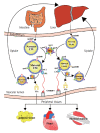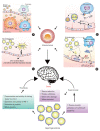Hypertriglyceridemia: A Neglected Risk Factor for Ischemic Stroke?
- PMID: 35135057
- PMCID: PMC8829486
- DOI: 10.5853/jos.2021.02831
Hypertriglyceridemia: A Neglected Risk Factor for Ischemic Stroke?
Abstract
Hypertriglyceridemia is caused by defects in triglyceride metabolism and generally manifests as abnormally high plasma triglyceride levels. Although the role of hypertriglyceridemia may not draw as much attention as that of plasma cholesterol in stroke, plasma triglycerides, especially nonfasting triglycerides, are thought to be correlated with the risk of ischemic stroke. Hypertriglyceridemia may increase the risk of ischemic stroke by promoting atherosclerosis and thrombosis and increasing blood viscosity. Moreover, hypertriglyceridemia may have some protective effects in patients who have already suffered a stroke via unclear mechanisms. Therefore, further studies are needed to elucidate the role of hypertriglyceridemia in the development and prognosis of ischemic stroke.
Keywords: Hypertriglyceridemia; Incidence; Ischemic stroke; Prognosis.
Figures


Similar articles
-
Fasting compared with nonfasting triglycerides and risk of cardiovascular events in women.JAMA. 2007 Jul 18;298(3):309-16. doi: 10.1001/jama.298.3.309. JAMA. 2007. PMID: 17635891
-
Hypertriglyceridemia as a possible independent risk factor for stroke.Acta Clin Croat. 2013 Dec;52(4):458-63. Acta Clin Croat. 2013. PMID: 24696996 Review.
-
Nonfasting triglycerides and risk of ischemic stroke in the general population.JAMA. 2008 Nov 12;300(18):2142-52. doi: 10.1001/jama.2008.621. JAMA. 2008. PMID: 19001625
-
Hypertriglyceridemia and ischemic stroke.Eur Neurol. 2008;60(6):269-78. doi: 10.1159/000157880. Epub 2008 Sep 27. Eur Neurol. 2008. PMID: 18824854 Review.
-
Triglycerides as a Shared Risk Factor between Dementia and Atherosclerotic Cardiovascular Disease: A Study of 125 727 Individuals.Clin Chem. 2021 Jan 8;67(1):245-255. doi: 10.1093/clinchem/hvaa269. Clin Chem. 2021. PMID: 33418579
Cited by
-
Dyslipidemia and Efficacy of Remote Ischemic Conditioning in Acute Moderate Ischemic Stroke: A Post Hoc Analysis of the RICAMIS Study.J Am Heart Assoc. 2024 Feb 6;13(3):e033130. doi: 10.1161/JAHA.123.033130. Epub 2024 Jan 31. J Am Heart Assoc. 2024. PMID: 38293927 Free PMC article.
-
Green Tea with Rhubarb Root Reduces Plasma Lipids While Preserving Gut Microbial Stability in a Healthy Human Cohort.Metabolites. 2025 Feb 19;15(2):139. doi: 10.3390/metabo15020139. Metabolites. 2025. PMID: 39997764 Free PMC article.
-
Comprehensive review on the pathogenesis of hypertriglyceridaemia-associated acute pancreatitis.Ann Med. 2023;55(2):2265939. doi: 10.1080/07853890.2023.2265939. Epub 2023 Oct 9. Ann Med. 2023. PMID: 37813108 Free PMC article. Review.
-
Multimodal Retinal Imaging of Intravascular Lipid in Severe/Extreme Hypertriglyceridemia.Case Rep Ophthalmol Med. 2023 Sep 27;2023:6698239. doi: 10.1155/2023/6698239. eCollection 2023. Case Rep Ophthalmol Med. 2023. PMID: 37800092 Free PMC article.
-
The paradigm change from reactive medical services to 3PM in ischemic stroke: a holistic approach utilising tear fluid multi-omics, mitochondria as a vital biosensor and AI-based multi-professional data interpretation.EPMA J. 2024 Feb 27;15(1):1-23. doi: 10.1007/s13167-024-00356-6. eCollection 2024 Mar. EPMA J. 2024. PMID: 38463624 Free PMC article.
References
-
- Campbell BC, De Silva DA, Macleod MR, Coutts SB, Schwamm LH, Davis SM, et al. Ischaemic stroke. Nat Rev Dis Primers. 2019;5:70. - PubMed
-
- Goldstein LB, Bushnell CD, Adams RJ, Appel LJ, Braun LT, Chaturvedi S, et al. Guidelines for the primary prevention of stroke: a guideline for healthcare professionals from the American Heart Association/American Stroke Association. Stroke. 2011;42:517–584. - PubMed
-
- Kernan WN, Ovbiagele B, Black HR, Bravata DM, Chimowitz MI, Ezekowitz MD, et al. Guidelines for the prevention of stroke in patients with stroke and transient ischemic attack: a guideline for healthcare professionals from the American Heart Association/American Stroke Association. Stroke. 2014;45:2160–2236. - PubMed
Publication types
Grants and funding
LinkOut - more resources
Full Text Sources

